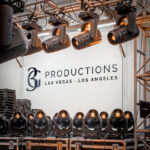For centuries, alchemists in Europe and Asia tried in vain to transform common metals into gold. The entertainment lamp manufacturing business unit of Philips Lighting in Turnhout, Belgium does it on a regular basis. Using sand, metal, and ceramics, they transform these very ordinary materials into a variety of extraordinary lamps for the entertainment industry, including MSR Gold FastFit lamps. Now they've started turning the same materials into Platinum.
Royal Philips Electronics, the parent company of Philips Lighting, began making lamps in 1891 in Eindhoven, the Netherlands. Brothers Anton and Gerard Philips saw an opportunity to meet the growing demand for incandescent lighting, and they built a factory to manufacture carbon-filament lamps under the company name Philips & Co. In less than 10 years, they were the among the largest lamp manufacturers in Europe.
Today, the Entertainment segment of Philips Lighting pumps out a large volume of lamps designed for entertainment luminaires. They command a large market share in this segment, and they have for many years. Before the days of automated lighting, they were closely aligned with manufacturers of studio luminaires and disco effects lighting. In the early 1980s when automated lighting was introduced and gained in popularity, they moved into this automated lighting market and established a firm hold.
The Heat is On
It's no accident that Philips Lighting is among the largest OEM suppliers in the industry. They actively pursue the market and devote 5 percent of their gross sales to the research and development of new technology. When the market wanted more light from their sources, Philips developed the MSR range of discharge lamps (see sidebar, "The Short Arc Lamp Frontier," below). When the market wanted higher color temperatures, they developed the MSR/2 range of lamps. Now the market is demanding even higher efficiency, as heightened awareness of the environment has led to the development of new alternative sources like LEDs, plasma, and more recently, Philips Platinum lamps. The pressure is on to compete.
You don't need to look too far to find evidence of the growing number of LEDs in the market. More conventional light sources are being overshadowed by emerging technologies. Is it justified?
The luminous efficacy of LEDs varies from about 25 lumens per watt up to over 100 lumens per watt, according to some manufacturer's data. But the collection efficiency, or how effectively the emitted light can be collected and output from the luminaire, is more of a challenge. And then there are the issues of cost, flicker, smoothness of dimming, color rendering, multiple shadows and imaging.
Compare and contrast LEDs to discharge lamps, and it becomes apparent that there are reasons to believe arc lamps are not ready to fade to black. An MSR 700, for example, has a luminous efficacy of close to 80 lumens per watt, which is typical for a discharge lamp. Now factor in the collection efficiency of the MSR 700 SA (short arc) and it's easy to see why manufacturers have recently rushed to introduce their own version of moving yoke fixtures with Philips short arc lamps, including Robe, Elation, PR Lighting, Coemar, Martin, Philips Vari-Lite, and others.
Shorter Arc, Better Lamp

Roger Van den Plas, senior product and marketing manager at Philips Entertainment Lighting, oversees the technological development of discharge lamps for the segment. "We are going in direction of short arc lamps, because with a shorter arc, you can get higher beam intensity, and so, higher brightness," he says.
But the gains come at a price, he adds. "To go to shorter arc, we also have to develop better lamp technology because the shorter arc results in a higher internal pressure. So the lamp has to be designed and constructed in such a way that it can withstand higher pressure in order to avoid arc tube eruptions."
As an example, Van den Plas and his team developed what they call P3 "pinch protection" technology, which allows lamps to operate at higher temperatures at any burning position. The pinch is the part of the lamp where the quartz envelope is heated to its melting point and literally pinched to seal in the gasses and additives. Because it creates a narrow neck, it is structurally the most vulnerable part of a lamp. But increased temperature and pressure are not the only concerns with short arc technology.
"The other thing with a short arc is that we have to take care of the color rendering index, because there is always a compromise between a short arc and the CRI. These are the keys to developing the right lamps for the entertainment industry."
From Gold to Platinum
In addition to improving lamp technology, Philips supports the use of electronic drivers, or switched-mode power supplies, as opposed to the use of magnetic ballast power supplies. "With old magnetic drivers," Van den Plas said, "the success of short arc would not be very positive – at least their performance on a magnetic ballast would not be good. Electronic drivers are helping to drive the penetration of short arc technology in the market because fluctuations on the mains voltage, the tolerances of the impedance of the power supply and the tolerances of the lamp voltage, taken together, can have a big effect on the wattage of the lamp. In an electronic driver, it's stabilized, which is a big step forward. The combination can make the lamp burn at higher wattage, resulting in more devitrification and shorter lamp life."
The MSD Platinum 5 R lamp is one example of Philips' new lamp technology. It has a very short arc, a life of 2,000 hours, a good color rendering index (CRI) and a high color temperature. But more importantly, it has an efficacy of about 50 collected lumens per watt and an integral dichroic glass reflector. When it's used with an electronic driver, it competes very favorably with the new plasma lamp technology. Elation was impressed enough to use it in their new Platinum Spot 5R automated luminaire. At 14.25" by 13.25" by 17.75," the 29-pound fixture benefits from the small lamp package and relative low heat produced by it, yet it appears to be as bright as the Elation Design Spot 575. It's another stepping stone on the way to smaller, lighter, brighter, and more affordable luminaires, helped along by better lamp technology.
Filling Out FastFit
Another important pursuit in Philips technology portfolio is the development of a complete range of FastFit lamps. FastFit is a form factor that enables easy lamp replacement from the rear of a fixture, rather than through the inside front of the fixture. It was developed by Philips and Bender & Wirth, the lamp socket manufacturer. Today, there a number of FastFit lamps in the range, including the MSR Gold 300 MiniFastFit, MSR Gold 700 FastFit, MSR Gold 1200 FastFit, MSR Gold 1500 FastFit, MSR Gold 2000 FastFit and a range of Halogen Hi-Brite incandescent lamps. And they have recently expanded the range to include the MSR Gold 2500/2 FastFit, and two new FastFit halogen lamps, the Hi-Brite 750 FastFit and the Hi-Brite 800 FastFit. In addition, there is a new range of MiniFastFit with a smaller base, allowing for the design of smaller fixtures. These include the new MSR Gold 300/2 MiniFastFit, MSR Gold 575/2 MiniFastFit, to be launched at Prolight & Sound and MSR Gold 700/2 MiniFastFit.
The FastFit range has been adopted by a growing number of manufacturers in the entertainment industry. At last count there were 70 fixtures made by 20 different manufacturers using the technology. Among the latest fixtures to hit the market with the new lamps are the, Robe Robin 300, Clay Paky Alpha 700, Philips Vari-Lite VL-500CD and VL-1000 and the Barco/High End Systems Showbeam 2.5. More manufacturers, no doubt, are working on new fixtures that use these lamps as this is written, just as Philips is working on a further extension of the MiniFastFit, higher wattage FastFit lamps and FastFit halogen lamps.
The Next Step
But Philips has no intention of ignoring alternative light sources like LEDs. Royal Philips Electronics tipped their hand in 1999 when they formed Lumileds Lighting with Agilent Technologies, and again in 2005, when Philips acquired a controlling stake in the LED manufacturer. In 2007, Philips sent shockwaves throughout the industry by acquiring Color Kinetics.
"The next step," Van den Plas said, "is the development of LEDs. But LEDs will not replace high wattage discharge lamps in the coming years," he says with an emphasis on the "s," as if to remove all doubt that discharge lamps will be around for some while. "For sure not in spot applications," he adds. "I think that LEDs will be replacing discharge lamps in wash applications up to 575 watts, 700 watts, maybe even going to 1200 watts, as well as in low wattage spot applications. But not yet higher wattage spot applications. There is a general trend towards LEDs, and LEDs have the advantage that they have very good colors, especially in the red, green, and blue. The white output of an LED is not quite as good as the output of a discharge lamp. Today we see LEDs as decoration in shows and as wash lights but not yet as spotlights. And the reason why is because in a spot, you need a compact light source and LED is not yet (able to do that)."
Toward that end, Philips recently introduced an LED module with an RGBW array. It is currently being used by ADB of France and DeSisti Lighting of Italy. It's designed for the studio and theatre market and specifically more for applications like a cyclorama, such as ADB's ALC4. It has four 40-watt Lexel RGBW LED modules with an asymmetrical reflector.
The Right Light
Even with a consistent research and development program, new products, and an eye toward the future, no company, however big or small, can take their market share for granted. Philips is no exception. How have they managed to keep their market share all these years?
Van den Plas says it's about paying attention to the customer. "Because we are focused on the market segment and we understand the market needs and the market requirements," he says. "We are always talking to end users, lighting designers, and also OEMs, and by doing that, we are able to develop the right light sources they are looking for and bring new products to market."
To that end, Philips exhibits at endless trade shows and conducts face-to-face meetings with end users. "We invite lighting designers, we have good contacts with rental houses, which I also consider end users, because a rental house is very close to the end user, and also because of our contacts with OEMs and they have a lot of contacts with lighting designers. So it's all the input that we have to collect to define what direction or what the road map must be for future development."
Ah, the Philips road map. Van den Plas speaks of it as if is it is a living, breathing document, unfolded before him like a general surveying the battlefield.
"The road map for the next 10 years is FastFit, short arc and LEDs," Van den Plas says. "At LDI, we had a further extension of the FastFit range, the MiniFastFit, as well as the FastFit, and that will continue in 2010. You also saw that we introduced the MSD Platinum 5 R. Before, we had the Gold range; now we have the Platinum."
Despite the worldwide economic downturn, Philips has continued to follow their roadmap and mine it for Gold and Platinum. Some might even call it a treasure map.
The Short Arc Lamp Frontier
MSR is a TLA (three letter acronym) for medium source rare earth. "Medium source" refers to the arc gap size and "rare earth" refers to the chemical additives that fill out the spectrum. In the early days of arc lamps (also referred to as discharge lamps), the arc gap was relatively large. By decreasing the arc gap, the light can be gathered with a reflector more effectively, therefore increasing the efficiency of a luminaire. Medium source lamps have an arc gap ranging from 4mm in an MSR 125 HR (hot restrike) to 35mm in an MSR 18000 HR.
Short arc lamp technology is one of the new frontiers in research and development. The arc gaps range from 3mm in an MSR 400 SA to 7mm in an MSR 2000 SA. These lamps have been the primary drivers in the move towards smaller and brighter luminaires, but they don't come without a price. The smaller arc configurations produce much higher internal pressure and temperatures, which have to be managed more carefully in order to preserve lamp life. If the temperatures exceed the maximum allowable, then the lamp will devitrify fast and fail sooner.
Devitrification is the process by which the clear or transparent nature of glass or quartz is changed to opaque through repeated heating and cooling. The quartz envelope in a lamp loses transparency through use, and in the process, the lumen maintenance suffers. Excessive heating can speed the process.
New developments in materials and techniques pioneered by lamp manufacturers like Philips have enabled them to bring a range of short arc lamps to market.


